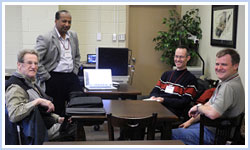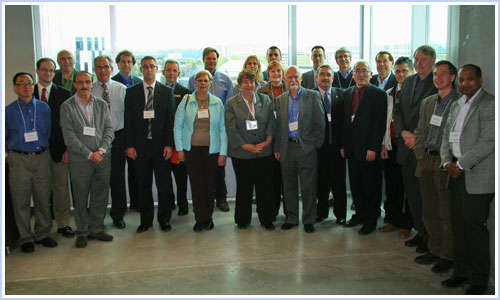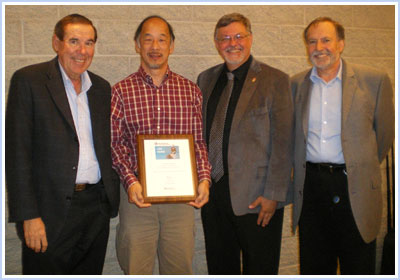MINERVA 2011 E-NEWSLETTER
| In this issue: |
Vol. 11/No. 1 Fall 2011
|
Our mission to see more H&S added to the core curriculum of post-secondary teaching institutions is far from over. We are a volunteer not-for-profit organization that must rely on continued government and corporate funding to get our work done. I invite you to get involved. More information on Minerva sponsorship opportunities can be found on our website or by contacting us at minerva@safetymanagementeducation.com. I wish to thank our many volunteers from industry, government, academia, and H&S professional associations who make up our Board of Directors and Working Committee for their endless dedication and assistance. I am also grateful to our many sponsors whose continued support and financial assistance make our efforts at Minerva Canada possible. I hope you will enjoy this edition of Minerva Update. Never hesitate to contact us atMinerva@safetymanagementeducation.com with comments and suggestions. A.E. Pasteris FEATURE HIGHLIGHT 2011 SUMMER INSTITUTE: LEADERSHIP AND COMMITMENT
“Informative, practical, interesting” is how Mehrab Merhrvar, Chair of Chemical Engineering at the University of Toronto, summed up the 8th Annual Minerva Canada Summer Institute where he was one of 28 academics from across Canada who participated in this May 2011 event designed to introduce engineering professors, teachers, and lecturers to the principles of teaching safety, health, and environmental management. “I particularly liked the line up of strong speakers at the outset.”
“Culture requires top down commitment and building systems from the bottom up,” Elizabeth said. “We can create a generation of graduates who have a fundamental belief they can go home safely and supervise people with that belief.” She emphasized there are many resources available to help universities do that, and encouraged participants to utilize them. For example, Workplace Safety and Prevention Services helps companies build health and safety into how people think, act and behave and can provide opportunities to improve culture.
The answer to this latter question was well demonstrated in a presentation about how DuPont instils the right safety culture and management systems. The $31 billion company with 60,000 employees operates in 90 countries with the fundamental core value that management must be fully committed, engaged and involved in safety. John Foster, SME Product Stewardship Sustainability Manager at Dupont, and Nina Mankowitz, General Manager, Health and Safety at Canada Post and formerly with DuPont, outlined these tools that DuPont uses to instil safety commitment:
Based on the lessons learned at the mine, Slack posed these questions to the Summer Institute participants:
His key message: “New grads have choices. They do not have to work for an unsafe employer.” Safety must be intuitive
How to improve safety education
“There is plenty of room to improve safety education,” he reinforced. “In almost any situation, you can identify and analyze hazards and make things real for students, then discuss the risks and recommendations for mitigating them.” Taking Minerva into the classroom
What engineering professors want to know about health and safety
Summer Institute in action CEOs TALK ABOUT INSTILLING THE RIGHT SAFETY CULTURE
A highlight of this year’s Partners In Prevention Health and Safety conference, held in Toronto and hosted by Health & Safety Ontario, was a panel discussion, moderated by Amanda Lang, co-host of the Lang & O’Leary Exchange. The session was sponsored by Workplace Safety and Prevention Services, Minerva Canada and the Conference Board of Canada. The panelists included: Ted Moroz, President, The Beer Store and Brewers Distributor Limited, Roy Slack, President, Cementation Canada Inc., Frank Saunders, Vice President, Nuclear Oversight and Regulatory Affairs, Bruce Power, and Steve Jones, President, The People Bank. These leaders shared their perspectives on how they built a health and safety culture that translated into successful business results: On how health and safety became part of your business model and not just a ‘nice to do’: Moroz: In the early 2000’s, we adopted health and safety as a core value and health and safety initiatives are front and centre in everyone’s score cards. Our commitment to health and safety was also negotiated into the collective agreement. Saunders: We built trust first by telling employees to stop any work if they were not sure it was safe. If so, change procedures would then be generated. Slack: We established a corporate culture of safety through the managers and supervisors. It can be challenging to get new people on board as soon as possible rather than having them dilute the culture. Jones: We focus on activities like worksite inspections because looking at results is too late – they’re a lagging indicator. On the role of the CEO: Moroz: We are the keeper of the keys and have to live and breathe health and safety if we expect people to embrace it. I attend as many training sessions as possible. It’s also important for CEOs to surround themselves with people who share the same values. Slack: Our published values are an opportunity to demonstrate commitment. The CEO has a lot of control over what the values are, and must visibly demonstrate commitment. Saunders: Visibility is key because people believe what they see. For example, the subject of safety should be raised frequently in the executive boardroom. Frequent communication throughout the organization is also very important. Jones: I believe what you measure is what you get. Communicate to people how, when and why you are measuring and tie that into compensation. On what to measure: Jones: We all measure the same standard things such as lost time injuries and medical aid frequency but those are results. It’s important to focus on activities that get results and they must be very specific and measurable and attainable. Everything measured should be in a timeframe and the more frequent, the better. On how to develop the right management model: Moroz: We developed a home-grown model and found best practices in industry. We branded our health and safety program as “Getting to Zero”. Slack: We started out with an adaptive model, taking the best from what we saw. There was a step change after we asked employees in focus groups what is working and what is not, and then started a number of initiatives based on their input. Saunders: There are standards to follow in our industry and we do our customizing. The first big step is to understand the risks of your business and then build a program around that. Jones: Tap into safety groups and associations that bring together best practices. This is a really cost-effective way to find them. We achieved a 98% reduction in claims costs over seven years due to tapping into these resources and best practices. LATEST NEWS
Dr. Graeme Norval, Associate Chair and Undergraduate Coordinator of the Department of Chemical Engineering and Applied Chemistry, University of Toronto, and Dr. Robert Hickey, Business Professor, Industrial Relations, School of Policy Studies, Queen’s University, were presented with the inaugural Minerva Canada Education Awards of Honour during the Summer Institute dinner on May 30. The award recognizes the professors’ contributions to advance safety and health education in Canadian universities. Both individuals will be inducted into the Minerva Canada Education Hall of Fame, which is being established this year. Graeme has made numerous contributions to Minerva Canada, including organizing and leading several Summer Institutes, developing new teaching modules as well as having Minerva Canada showcased and involved in engineering classes and student projects at the University of Toronto. “Graeme is an instrumental person and an ambassador for Minerva Canada,” says Tony Pasteris, Chairman and President, Minerva Canada. “He has a true passion for safety in everything he does from lab safety to you name it. He has provided outstanding leadership in chairing Minerva’s Summer Institutes and drawing in professors to attend.” “You don’t do it for an award,” says Graeme. “It’s the right thing to do and that’s why I do it.” A supporter of the teaching of health and safety in Canadian universities, Robert’s most recent contributions are case studies, written for Minerva Canada and focused on Health and Safety for theICBC competition. He also plans to write two more case studies for next year’s competition. We are compiling videos for YouTube uploading that will highlight key Minerva activities and people’s experiences teaching health and safety in the classroom. Stay tuned! Stop That Train! Students Design Device to Put the Brakes on Runaway Trains
The winners of this year’s James Ham Safe Design Award – Ryerson University engineering undergraduate students Vikram Sharma, Jon Zorzi, Husain Amiji and Mohammad Khan – were presented with their awards at the Minerva Summer Institute in May. The team designed an On Board Emergency Derail, which could be activated by a crew member of a runaway train. Team leader Husain was thrilled to win the award because “students usually only think of function and aesthetics, not safety.” For the father of three who witnessed a tragic accident when he worked as a train conductor back in 2006, safety is very personal. “It’s an issue connected to my heart,” he explains, “and I’m very passionate about it. If something is not safe, it should not be produced. “When we won, I felt validated that my idea was not crazy. We thought outside the box to design something controversial.” He adds that the team will put the $3,500 prize towards patenting the design and making it more practical. According to project supervisor Vincent Chan, the team held weekly meetings for the entire semester to discuss design, issues, technology, and control. “Our initial design was very simple,” recalls Husain. “Dr. Chan helped immensely to make it fail safe.” “We’re very proud of our students,” says Jacob Friedman, Associate Chair, Director-Mechanical Engineering, Ryerson University. “And this project dovetailed with requirements for our Capstone course, so not only did the students get an award, but a course credit, too.”
The Queen’s University team of Mohammed Mohammed, Nasr Mustafa, Fady Ghabros andMazen Shehada took second prize of $1,500 for their design of a Temporary Free Standing Guardrail system to enhance fall protection capabilities. The award honours James Milton Ham whose Royal Commission Report on Health and Safety led to the creation of Ontario’s Occupational Health and Safety Act in 1979 and the adoption of the Internal Responsibility System in Ontario workplaces. The winning teams were honoured by Minerva Canada President and CEO Tony Pasteris and other Board members during ceremonies at each of the two universities. Award submissions are judged annually by members of Minerva’s Board and Working Committee. Concordia Team Clinches ICBC Competition
For the second year, Minerva Canada sponsored the Health and Safety Human Resources event at the Inter Collegiate Business Competition (ICBC), Canada’s premier undergraduate business case competition which brings together the brightest students from top business schools across North America, Asia and around the world, held at Queen’s University in January. Minerva Board membersNina Mankovitz, Frank Saunders, Peter Sturm, Marcel Pouliot, Vic Pakalnis and Minerva Canada President Tony Pasteris acted as judges of the six student team presentations in the final round. Final round competitors are given four and a half hours to prepare a 15-minute oral presentation before the judges. In addition, the final round includes an entertaining debating event. Two case studies, a preliminary and final, were written by Rob Hickey, Business Professor, Queen’s Industrial Relations, who will produce two additional case studies for the 2011-2012 competition. The case studies will eventually be posted to the Minerva website. “A big thank you to all our Minerva judges for taking time out from their busy work schedules and toMarcel Pouliot and Vic Pakalnis for also helping with the case studies,” says Tony Pasteris. “On behalf of all of us at Minerva, I want to thank Rob Hickey for doing an excellent job writing both case studies as well as to the ICBC executive committee at Queen’s who were outstanding hosts. In particular, I wish to thank Mandy Tran and Jacob Trenholm of Queen’s who coordinated all the activities for the Minerva event.” Winners of this year’s Minerva Safety Management Education Human Resources Event: The other three finalists were Wilfred Laurier, Hong Kong Polytechnic University and Saint Mary’s University. Congratulations to all six university teams for very professional presentations. “Drive to Zero” Culture Pays Off in More Ways than One
Congratulations to 2010 National Safety Council’s Robert W. Campbell Award winner Dow Chemical Company. The Robert W. Campbell Award, which has Minerva Canada as one of its global partners, recognizes organizations that demonstrate how integration of environmental, health and safety (EH&S) management within business operations is a cornerstone of their corporate success. EH&S efforts have been viewed as critical to Dow’s success throughout its 113-year history. Dow’s 2005 goals set the company apart in EH&S and advanced a “drive to zero” culture companywide. Its achievements did not come at the expense of business performance. By investing close to $1 billion in improving resource productivity, such as reducing energy usage, wastewater generation, and chemical emissions, Dow achieved a return of more than $5 billion in direct cost avoidance, future and contingent liabilities avoidance, as well as intangible internal costs. In addition, the company has saved an estimated $1 billion alone in avoidance of injuries, illnesses, leaks, breaks, and spills. It is currently working toward its 2015 Sustainability Goals, which go far beyond reducing injuries and environmental releases. Minerva Board Member Len Hong was involved in assessing the 2010 entries in the competition. Minerva Canada is a long-time supporter of the Campbell Awards. Minerva-sponsored Webpage Created by Students, for Students
Earlier this year, Minerva sponsored a first year University of Toronto engineering student project to create a Minerva student webpage. The page, designed by a University of Toronto team of five as part of their course workload, is in response to the question, “What kind of information should students have available on health and safety?” The goal is for the students to define what that web page will contain and, once completed, Minerva will build it based on the team’s research and recommendations. Team member Deepkanwal Plaha (shown above) admits that the team had difficulty finding H&S information relevant to the course material. “But it was a really good learning experience,” he explains. “None of us knew much about health and safety before the project, but now appreciate and understand the principles of H&S.” Stay tuned! Minerva was also involved in another University of Toronto engineering student project to assess engineering students’ knowledge of health and safety as they enter university. It also hopes to be involved in a project to survey industry’s needs in H&S education from engineering and business graduates they hire. The intelligence gathered from these surveys will be used to help guide the Minerva-sponsoredteaching module content. It is designed to cover H&S education needs for all four years of undergraduate engineering and will be made available to Canadian universities.
“Because the University of Toronto has such a strong international reputation for its engineering program, it felt really good to be recognized by that university,” says Marc. “On behalf of all of us at Minerva Canada, congratulations, Marc,” says Tony Pasteris. “It speaks for all your outstanding contributions to engineering education within Canada.” Health & Safety Seminars Stimulate Discussion
The three seminars had students reviewing various H&S material found on the internet, including a Minerva case study, and the material was subsequently discussed in class with the students. Minerva will continue providing this teaching assistance in 2011. Institutional Collaboration: BCRSP National Education Symposium
In his presentation, Tony reiterated that Minerva Canada views professional associations as essential partners to further advance H&S education in post-secondary teaching schools. “Minerva actively supports the idea that health and safety education is in all our interests. It’s a need, not a want,” said Tony. The BCRSP has been very successful furthering this cause for a long time. I believe that opportunities exist to strengthen alliances between our two organizations for the betterment of future health and safety professionals and the organizations they serve. Minerva Canada can be a dependable partner and resource for BCRSP stakeholders. I sincerely thank the BCRSP for fostering this partnership with Minerva.” Engineering Educators on Board with the Minerva Message
The first morning provided a forum for all of the conference participants to hear Tony Pasterisintroduce the mission, vision and goals of Minerva Canada. Vic Pakalnis (Queen’s University) andGraeme Norval (University of Toronto) were on hand to lead a lively and interactive workshop on the fundamentals of health and safety, as well as to host other sessions within the conference. They introduced faculty who had not been exposed to industrial safety standards and management systems to ensure that they left with an understanding of SHE fundamentals, as well as various tools and information which they could use in their courses. Participants were shown the variety of teaching resources (prepared lectures, case studies, on-line tests) that are already developed and readily available. A follow up to the standing-room-only workshop on the final day of the conference provided a review and discussion of case study resources for faculty who were trying to incorporate OH&S material in their course curriculum. Minerva Canada was also instrumental in bringing in Roy Slack, President of Cementation Canada, to talk about the company’s experience during the 2010 Copiapó mining accident when part of the San José copper-gold mine in the Atacama Desert near Copiapó, Chile, collapsed, leaving 33 men trapped 700 meters below ground. The Terraservice group (that partnered with Cementation) was the first drilling contractor to break a hole through to confirm that the workers were alive. Roy gave a brief overview of that drilling program and the rescue in general, the lessons learned from which are universally relevant. Based on the success of and professor feedback from the workshop, Minerva intends to be a continued partner and associate member of the CEEA, which was created in 2010 with a mission to “enhance the competence and relevance of graduates from Canadian engineering schools through continuous improvement in engineering education.” The Canadian Engineering Education Association 3rd Annual Meeting – Examining Future Directions for Engineering Education – will be held in Winnipeg, June 17 – 20, 2012. The local arrangements Committee intends to feature three workshops, including a Minerva developed Safety workshop that builds on the success of the 2011 offering in St. John’s. Details regarding the Conference and the workshops can be found at www.ceea.ca. Minerva has been featured in two recent publications:
Manitoba An additional application has been made to the University of Manitoba to extend the Chair in Design Engineering that Ron Britton has held since 2001. A new Design Engineering Chair would allow the continuation of the association with Minerva that characterized Ron’s Chair. Stay tuned!
For the second consecutive year, the University of Calgary hosted the Minerva Alberta Learning Forum in May 2011. A total of 38 participants from industry, government, universities and colleges gathered and shared their views on health and safety in the region through panel discussions and one-on-one interaction. The focus of the forum was on promoting health and safety education in the engineering and business schools across Alberta to prevent injuries and deaths in the workplace. Sessions included the Fundamentals of Process Safety and Risk Management and some leading practices to teach them. Another highlight was a panel-led lively discussion on what industry wants to see from university graduates. “I appreciated the friendly, passionate, active atmosphere, and absolutely loved hearing from the experienced speakers,” said one participant. Many thanks to Anis Haque, Department of Electrical and Computer Engineering, University of Calgary and a Minerva Board member, for all his hard work pulling the forum together. British Columbia MEET OUR 2011 MINERVA NATIONAL BOARD President & Chair: A.E. (TONY) PASTERIS Secretary/Treasurer: RENZO DALLA VIA Meeting Coordinator: SHERRIE JOHNSTON DR. RON BRITTON JOHN FOSTER DR. PAUL GALLINA DR. ANIS HAQUE RENU KULENDRAN NINA MANKOVITZ ART NORDHOLM VIC PAKALNIS MARCEL E. POULIOT DR. MARC ROSEN FRANK SAUNDERS JOHN STROYAN PETER STURM
A special thank you goes to Len Hong, recently retired President & CEO, Canadian Centre for Occupational Health & Safety, for his unwavering support and many contributions to the organization over the years, as both a Board Member and the Co-chair of the Ontario Working Committee. We also extend a heartfelt thank you to retiring Minerva board members Doug McCutcheon,Professor, Engineering Safety and Risk, Management Program, Faculty of Engineering, University of Alberta, and Paul Bates, Dean, DeGroote School of Business, McMaster University, for their numerous and much-appreciated contributions to Minerva over the years. And… welcome aboard to new board members: Minerva Canada’s key sponsors from industry, academia, government and H&S associations include a growing list of organizations committed to principles that combine efficiency and productivity within an effective Safety, Health and Environmental Management (SHE) culture. It is with deep gratitude that we acknowledge our sponsors and close working partners: Bruce Power University financial supporters of Summer Institute, Learning Forum Engineering Student Teaching Modules in Development Five universities – the University of Toronto, Queen’s University, University of Western Ontario, the University of Calgary and the University of Alberta – have agreed to assist Minerva with developing the modules and pilot the modules. Module development for first year students is underway under the leadership of Vic Pakalnis of Queen’s University – all five universities are expected to pilot the first year modules by the end of 2012. Subject matter experts from industry, government and health and safety associations will be asked to be guest speakers at universities and deliver some of the modules when requested by universities. Funding for the project will be sought from government and industry, with funds given to the five universities to develop the modules. For more information about the modules and how to support this initiative, contact Minerva@safetymanagementeducation.com. Stay tuned on this ambitious project from Minerva Canada. Upcoming Case Studies
R.W. Campbell Award Winner Case Studies Available Special Report
Minerva Canada Chairman & President: A.E (Tony) Pasteris Editor: Susan Baka |

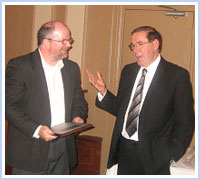

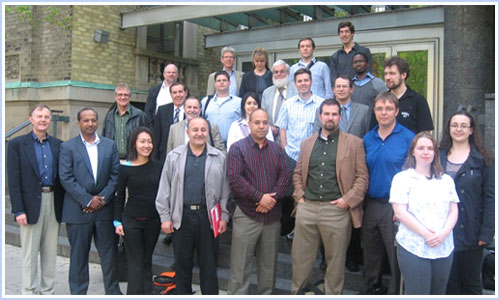
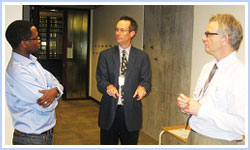
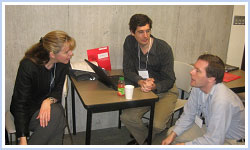
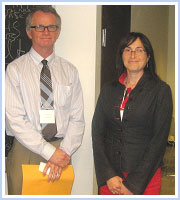
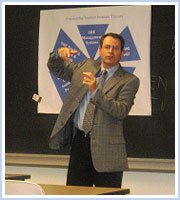
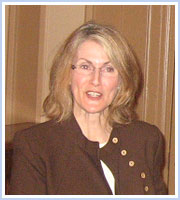
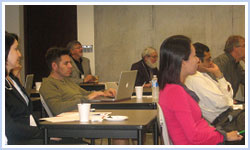 Strengths and weaknesses of teaching this at other universities
Strengths and weaknesses of teaching this at other universities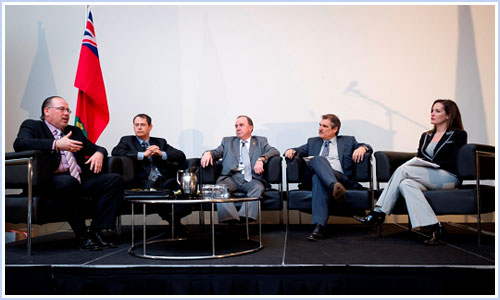
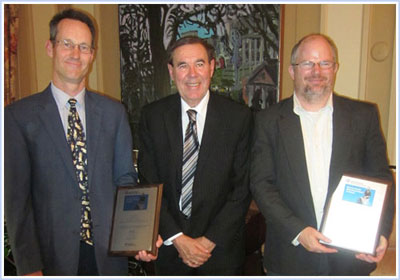
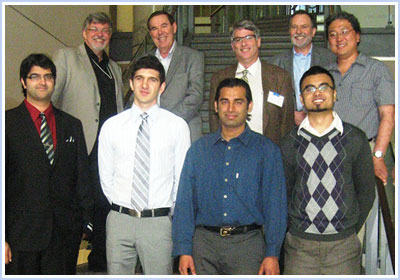
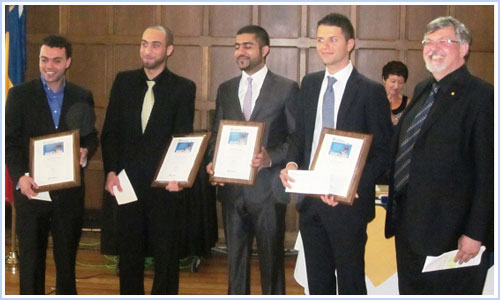
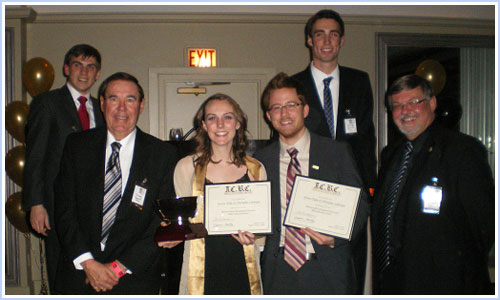
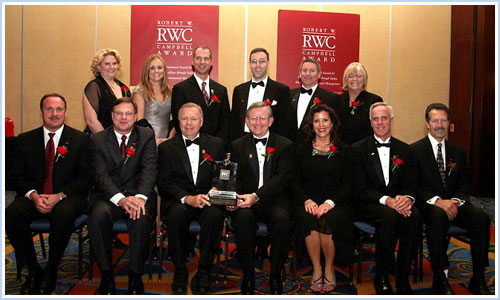
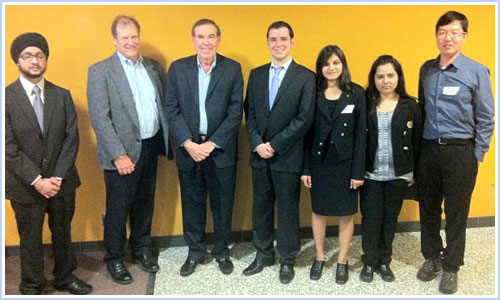
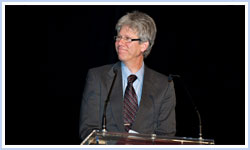 We heartily congratulate Marc Rosen, Professor and Founding Dean, Faculty of Engineering and Applied Science, University of Ontario Institute of Technology, for being selected in November by his peers for membership into an assembly of extraordinary alumni, the University of Toronto’s Engineering Hall of Distinction. The careers of the members stand as examples and add a sense of reality to the aspirations of successive generations of engineering students. As an educator and scholar, Marc has transformed educational institutions throughout his career and made exemplary contributions to research.
We heartily congratulate Marc Rosen, Professor and Founding Dean, Faculty of Engineering and Applied Science, University of Ontario Institute of Technology, for being selected in November by his peers for membership into an assembly of extraordinary alumni, the University of Toronto’s Engineering Hall of Distinction. The careers of the members stand as examples and add a sense of reality to the aspirations of successive generations of engineering students. As an educator and scholar, Marc has transformed educational institutions throughout his career and made exemplary contributions to research. In May, Tony Pasteris was invited to attend the National Education Symposium in Halifax, hosted by the Board of Canadian Registered Safety Professionals (BCRSP) and attended by educators of Canadian occupational health and safety teaching institutions. The BCRSP is the certifying body for occupational health and safety professionals. The CRSP designation is a widely accepted form of recognition by industry and governments across Canada.
In May, Tony Pasteris was invited to attend the National Education Symposium in Halifax, hosted by the Board of Canadian Registered Safety Professionals (BCRSP) and attended by educators of Canadian occupational health and safety teaching institutions. The BCRSP is the certifying body for occupational health and safety professionals. The CRSP designation is a widely accepted form of recognition by industry and governments across Canada.